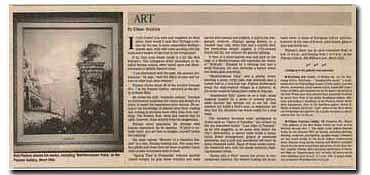The Star Ledger - Friday, October 27, 1995 By: Eilleen Watkins |
 |
If you closed your eyes and imagined an ideal place, what would it look like? Perhaps a terrace by the sea, in some unspecified Mediterranean spot, with wild roses growing over the walls and a basket of ripe fruit in the foreground? If so , then your dream locale is a lot like Bob Pejman's. The Livingston artist specializes in detailed fantasy scenes, often based upon real Mediterranean or Middle Eastern ruins. " I am fascinated with the past, the ancient civilizations," he says, "and the effect of time and nature on what man once created." Pejman shows about 20 of his acrylics though Nov. 7 at the Pejman Gallery, operated by his family in Short Hills. He terms his style "Romantic Realism," because he deliberately heightens the colors and details of a scene to make the experience more intense. He acquires his knowledge of historic sites from reading and looking at pictures more often than traveling. The flowers, fruit, birds and insects that he adds, however, come entirely from his imagination. Pejman never populates his setting with human characters. As he explains, "If there is nobody there, you are free to imagine yourself within the painting. His large canvas "Memory of a Vanished Empire" is a vast, Persian looking ruin. The many broken pillars and stone floor are done in golden tones, while purple mountains loom in back. "Spring Time in Persepolis" features another ruined temple, its gray stone columns and walls carved with animals and soldiers. A slab in the foreground, however, displays spring flowers in a cracked vase, lush, dewy fruit and a colorful bird" the meticulous details suggest a 17th Century Dutch still life, but without the gloomy lighting. A view of a white-marble seat and arch on the edge of a Mediterranean cliff expresses the theme of "Solitude." Flanked by a twisting tree and a small fountain, the seat overlooks a harbor where two boats glide peacefully. "Mediterranean Vista" sets a similar mood, showing a steep rocky path that descends past a ruined wall to a teal-blue bay. Pejman deliberately keeps the whitewashed villages at a distance, so the scene could be taking place today or long ago. "Abandoned Villa" places us on a wide, stone walkway headed for a series of covered arches, while another bay spreads out to our left. One cracked urn holds a bird's nest, to emphasize the idea that the structure has stood empty for a long while. The situation becomes more ambiguous in works such as "Gates of Paradise," the terrace on the sea described earlier. "Last Days of Pompeii," as its title suggests, is set some time before the city's destruction; a carved table holds a sumptuous flower arrangement, grapes of unnatural greenness, and a quill and parchment left there by some educated noble. Many of these works resemble theatrical sets, with the nearer elements framing dramatic vistas. "Room With a View" moves the action to contemporary America, the window looking out on Autumn trees. A sense of European culture survives, however, in the vase of flowers, piled books, glass of wine and Greek urn. |